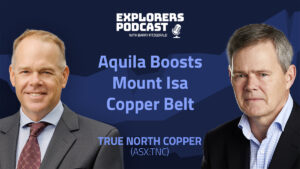$12,000 copper: Why Anglo’s red metal assets make the rest of it worthwhile

Pic: Getty Images
- ANZ says copper could hit US$12,000/t to incentivise the construction of new megamines needed for the energy transition
- The quality and unit costs of Anglo American’s South American copper mines seem to be enough to make the $70bn miner attractive to majors like BHP
- Junior and mid-tier copper miners are enjoying a lift with copper prices above US$10,000/t
Anglo American has plenty of wrinkles.
Three of its key business arms are heavily engaged in southern Africa. Two of them — Kumba Iron Ore and Anglo American Platinum — virtually entirely so.
Among those businesses AmPlats and De Beers, the world’s largest diamond company, are operating in what are currently two of the least attractive commodity markets in the world.
Surging to record highs only two years ago, palladium, platinum and diamond prices are now plumbing cyclical depths.
A major development project — the Woodsmith polyhalite potash mine in the UK — is also pretty unattractive with capex blowing out and potash prices on the nose.
Yet the century-old mining house is commanding bids for what would be the largest takeover in mining history — rejecting a $60 billion approach from BHP (ASX:BHP) a fortnight ago.
Glencore and Rio Tinto (ASX:RIO) are now said to be running the ruler over the embattled miner, with Reuters reporting immediately after BHP’s approach that Glencore executives were assessing the numbers on a bid internally.
Rio’s potential participation is founded on the logic it has little in the way of copper growth options outside its Mongolian Oyu Tolgoi mine if it’s Resolution mine in the USA, contested by some traditional owner groups, remains in the ground.
And like BHP, it also has the market cap to make an all scrip offer — though investors are interjecting on all sides BHP, Rio and Anglo American to either pursue a better deal or maintain the status quo.
The real jewels here are three Anglo divisions — its met coal mines in Queensland, which would appeal to BHP and Glencore, its high grade iron ore operation in Brazil which has synergies with BHP and Vale, and most importantly its copper division.
Recent forecasts from analysts and money men lay bare why copper desperation could drive a deal.
US$12,000/t? It could be the bare minimum
Anglo’s copper assets aren’t just big, they’re also highly attractive.
Now trading at around $70 billion AUD, the mining giant estimates we’ll need 233kg of copper a person to satisfy the needs of the energy transition.
We’ve currently mined and have in use just 61kg. That’s a near quadrupling in copper stock in a little over 25 years.
Anglo’s copper production — while falling short of expectations this year — is expected to rise from 664,000t in 2022 and 826,000t in 2023 to over 1Mtpa over the long run.
Its newest mine, Quellaveco in Peru, is expected to deliver 300,000tpa for its first decade at the bottom end of the global cost curve. It’s got a 35-year mine life.
Collahuasi, in which Anglo holds a 44% stake and is in partnership with Glencore, is the world’s second biggest copper producer after Escondida. It has 84 years of reserves with Anglo’s share running at between 250,000-300,000tpa.
Its Peruvian operations are expected to run at unit costs of just US110c/lb in 2024, with its Chilean mines to cost a dearer 190c/lb.
But that’s nothing compared to current copper prices. They’re around US$10,000/t or US$4.54/lb on spot.
ANZ’s commodity team Daniel Hynes and Soni Kumari say prices of US$12,000/t are now sorely needed to incentivise new operations and generate a bare rate of return of 10%. For reference, most mining giants look for rates of return in excess of 15% in new developments.
“Copper prices have rallied nearly 20% this year following a series of supply disruptions and better-than-expected demand in China. However, inflationary pressure means costs are also rising sharply. So much so that developers may still fail to reach financial targets for new greenfield projects,” they said in a new note.
“The ‘incentive price’ is the price required to incentivise the marginal greenfield
project to meet requirements over the long term. Assuming developers are looking for a 10% rate of return, we calculate a 300kt mine will need prices around USD12,000/t to achieve this return. Anything below that and they may be reluctant to proceed.
“In the short term, we expect copper prices to remain highly volatile as the market reacts to the challenging economic backdrop. However, we think prices will remain well supported, underpinned by a huge under supply of the copper required to feed the emerging energy transition.”
The biggest roadblock when it comes to copper supply has been the cessation of First Quantum’s Cobre Panama operation in Latin America, where community opposition has forced the early closure of a 350,000tpa operation — equivalent to around 4% of global supply.
Anglo’s higher cost Los Bronces in Chile has also underperformed.
“Overall, (Anglo) lowered its production guidance for 2024 to 730kt, from 1Mt,” Hynes and Kumari said.
“After a poor performance in 2023, mine supply challenges will likely continue, as
political unease in Chile is raising the risk of disruptions. ”
Hynes and Kumari noted supply growth has often lagged even in periods of higher prices and stronger margins. Even at a 90th percentile spread of US$5000/t in 2009 it took two years for supply growth to hit a bare 8%.
“The relationship suggests that with the price-to-cost spread recovering to around
USD1,800/t in recent months, some growth in mine supply may emerge in 2026,” they said.
“Based on the short-term project pipeline, that is likely. There are several small copper operations being commissioned that are due to begin producing metal over the next 18 months. However, we believe supply growth will keep rising only if prices rise further.”
Projects in the pipeline currently are unlikely to meet demand growth, with capex inflation also meaning an estimated US$7.5b is needed to build a new 300,000tpa mine.
“The current pipeline of projects likely to start producing in the next few years
represents only 2.3% of forecast supply, due to various project delays,” Hynes and Kumari said.
“Our current forecasts suggest the market is likely to tighten considerably later this
decade, with possible deficits of around 1Mt. Significant investment in new mine
capacity would be needed to reduce the gap.”
Copper enthusiasm helping smaller players
Copper’s pull is so strong it can, apparently, raise the dead.
Austral Resources (ASX:AR1) was provided a lifeline when its offtake partner Glencore assumed its debt and it was returned from the hands of receivers, putting the Queensland copper miner on a path to a recapitalisation.
The copper cathode produce has 810t of metal onsite ready for sale and 300,000t of ore grading an estimated 0.73% Cu waiting for processing.
“This is a very positive outcome for the Company, it puts us back in a strong position to move forward,” MD Dan Jauncey said yesterday.
“With copper prices and demand rising, we are entering a new era. The focus on restructuring Austral comes at an opportune time as the global market shows a robust appetite for copper.”
Anax Metals (ASX:ANX) saw its shares run almost 30% higher in morning trade yesterday after revealing a 32% lift in NPV for its Whim Creek project at spot copper, silver and gold prices, although zinc prices remain slightly below DFS projections on a US dollar basis (higher on an Aussie dollar basis).
ANX said it could also increase the life of its planned open pit, with the mine expected to spit out $520m in free cash over an eight-year life.
Hillgrove Resources (ASX:HGO) is up 32% over the past six months after reopening the Kanmantoo mine in South Australia this year.
Having began development on the restart in the middle of last year at $12,500/t (AUD) copper, at current prices it says the mine could deliver an additional $40m per annum in cash flow and potentially reduce its cut off grade.
AIC Mines (ASX:A1M), which delivered a solid March quarter and says it is on track to beat its FY24 production guidance of 12,500t at AISC of $5/lb, is up 51% over the past six months.
And the ASX’s top copper miner Sandfire Resources (ASX:SFR) is up a whopping 63% in the past six months, hitting an all time high of $9.80 and closing on a $5b valuation despite production challenges at its MATSA mine in Spain.
At the same time there has been a more muted response to underperformers like True North Copper (ASX:TNC) and Cyprium Metals (ASX:CYM).
Copper miners share prices today:
At Stockhead, we tell it like it is. While Anax Metals was a Stockhead advertiser at the time of writing, it did not sponsor this article.
Related Topics

UNLOCK INSIGHTS
Discover the untold stories of emerging ASX stocks.
Daily news and expert analysis, it's free to subscribe.
By proceeding, you confirm you understand that we handle personal information in accordance with our Privacy Policy.








